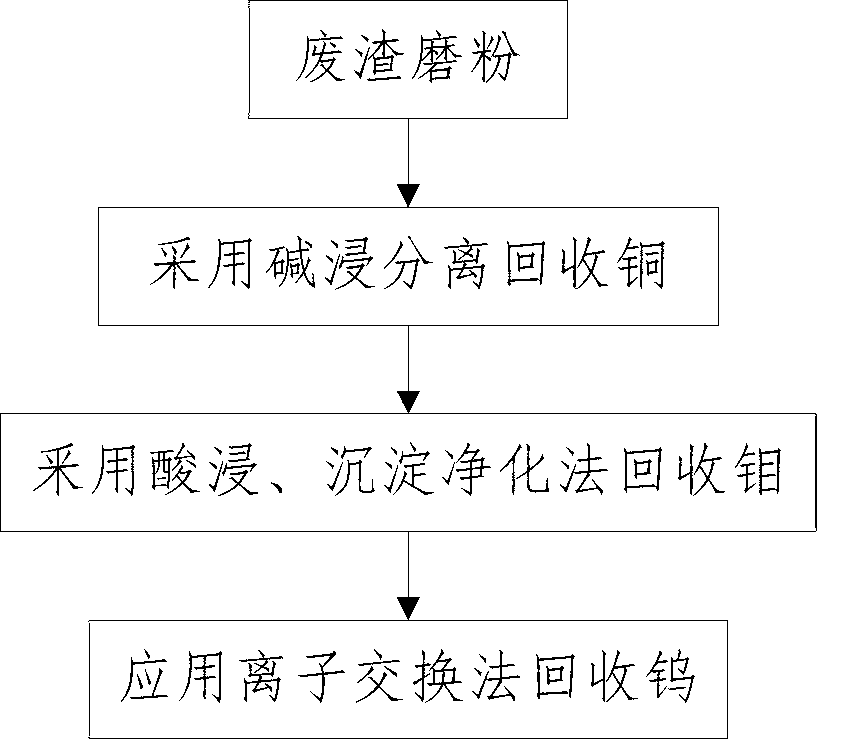Method for recovering copper, tungsten and molybdenum by use of APT (ammonium paratungstate) waste slag
A technology for recycling copper and waste slag, applied in the direction of improving process efficiency, etc., can solve problems such as resin poisoning, increase labor intensity, waste copper and tungsten, etc., achieve the effects of improving economic benefits, reducing resource waste, and improving utilization rate
- Summary
- Abstract
- Description
- Claims
- Application Information
AI Technical Summary
Problems solved by technology
Method used
Image
Examples
Embodiment 1
[0023] A method for reclaiming copper, tungsten and molybdenum by utilizing APT waste slag, the steps are as follows:
[0024] a. Grinding: Take 100kg of waste residue, of which WO 3 The content is 6%, the Mo content is 15%, and the Cu content is 24%. The waste residue containing copper, tungsten and molybdenum produced in the production process of ammonium paratungstate is ground to -325 mesh ≥ 90%.
[0025] b. Separation and recovery of copper by alkaline leaching: use a softening material with a pH value of 7.5 to filter to separate the slag containing copper from the solution containing tungsten and molybdenum; then leaching the slag containing copper with alkali, wherein the alkali is NaOH, When the alkali concentration is 35g / L, stop adding alkali, stir while raising the temperature, boil and keep warm for 1.5h, recover and obtain copper sulfide 23.11kg after washing, and the recovery rate of Cu in this step is 96.3%.
[0026] c. adopt acid leaching, precipitation purif...
Embodiment 2
[0029] A method for reclaiming copper, tungsten and molybdenum by utilizing APT waste slag, the steps are as follows:
[0030] a. Grinding: Take 100kg of waste residue, of which WO 3 The content is 6%, the Mo content is 15%, and the Cu content is 24%. The waste residue containing copper, tungsten and molybdenum produced in the production process of ammonium paratungstate is ground to -325 mesh ≥ 90%.
[0031] b. Separation and recovery of copper by alkaline leaching: use a softening material with a pH value of 8.5 to filter to separate the slag containing copper from the solution containing tungsten and molybdenum; then leaching the slag containing copper with alkali, wherein the alkali is NaOH, When the alkali concentration is 45g / L, stop adding alkali, stir while raising the temperature, boil and keep warm for 2.5h, recover and obtain copper sulfide 23.472kg after washing, and the recovery rate of Cu in this step is 97.8%.
[0032] c. adopt acid leaching, precipitation puri...
Embodiment 3
[0035] A method for reclaiming copper, tungsten and molybdenum by utilizing APT waste slag, the steps are as follows:
[0036] a. Grinding: Take 100kg of waste residue, of which WO 3 The content is 6%, the Mo content is 15%, and the Cu content is 24%. The waste residue containing copper, tungsten and molybdenum produced in the production process of ammonium paratungstate is ground to -325 mesh ≥ 90%.
[0037] b. Separation and recovery of copper by alkali leaching; use a softening material with a pH value of 8.0 to filter and separate the slag containing copper from the solution containing tungsten and molybdenum; then leaching the slag containing copper with alkali, wherein the alkali is NaOH, when When the alkali concentration is 40g / L, stop adding alkali, stir while raising the temperature, boil and keep warm for 2h, recover and obtain copper sulfide 23.352kg after washing, and the recovery rate of Cu in this step is 97.3%.
[0038]c. adopt acid leaching, precipitation pur...
PUM
 Login to View More
Login to View More Abstract
Description
Claims
Application Information
 Login to View More
Login to View More - R&D
- Intellectual Property
- Life Sciences
- Materials
- Tech Scout
- Unparalleled Data Quality
- Higher Quality Content
- 60% Fewer Hallucinations
Browse by: Latest US Patents, China's latest patents, Technical Efficacy Thesaurus, Application Domain, Technology Topic, Popular Technical Reports.
© 2025 PatSnap. All rights reserved.Legal|Privacy policy|Modern Slavery Act Transparency Statement|Sitemap|About US| Contact US: help@patsnap.com

